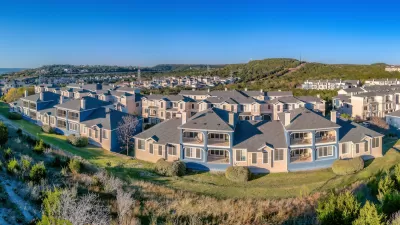Legislation to stop construction of McMansions is being undermined by a zoning loophole.

"In 2008, [Los Angeles] enacted rules designed to crack down on the size of new residences in areas zoned for single-family housing. After the original ordinance was criticized for being too lenient, it was strengthened in 2017, limiting the square footage of homes to 45 percent of a lot’s size," writes Zoie Matthew.
But in the Melrose area of the city, developers are still putting up McMansions, which are driving up home prices and dwarfing surrounding homes. The issue is they are building single-family homes on lots zoned for multifamily buildings.
"In these zones, which were not covered by the original anti-mansionization legislation, developers are allowed to build multiple units—but are not required to build up to the maximum density," says Matthew.
Even with ongoing debates throughout the state about upzoning, city officials and residents want the McMansion construction to stop. "[Councilmember David] Ryu says he plans to introduce legislation in the coming weeks that would expand the baseline mansionization ordinance to multifamily lots, in an attempt to close the loophole," notes Matthew.
FULL STORY: LA cracked down on McMansions. Developers are still building them.

Trump Administration Could Effectively End Housing Voucher Program
Federal officials are eyeing major cuts to the Section 8 program that helps millions of low-income households pay rent.

Planetizen Federal Action Tracker
A weekly monitor of how Trump’s orders and actions are impacting planners and planning in America.

Ken Jennings Launches Transit Web Series
The Jeopardy champ wants you to ride public transit.

Washington Legislature Passes Rent Increase Cap
A bill that caps rent increases at 7 percent plus inflation is headed to the governor’s desk.

From Planning to Action: How LA County Is Rethinking Climate Resilience
Chief Sustainability Officer Rita Kampalath outlines the County’s shift from planning to implementation in its climate resilience efforts, emphasizing cross-departmental coordination, updated recovery strategies, and the need for flexible funding.

New Mexico Aging Department Commits to Helping Seniors Age ‘In Place’ and ‘Autonomously’ in New Draft Plan
As New Mexico’s population of seniors continues to grow, the state’s aging department is proposing expanded initiatives to help seniors maintain their autonomy while also supporting family caregivers.
Urban Design for Planners 1: Software Tools
This six-course series explores essential urban design concepts using open source software and equips planners with the tools they need to participate fully in the urban design process.
Planning for Universal Design
Learn the tools for implementing Universal Design in planning regulations.
Heyer Gruel & Associates PA
Ada County Highway District
Institute for Housing and Urban Development Studies (IHS)
City of Grandview
Harvard GSD Executive Education
Toledo-Lucas County Plan Commissions
Salt Lake City
NYU Wagner Graduate School of Public Service




























